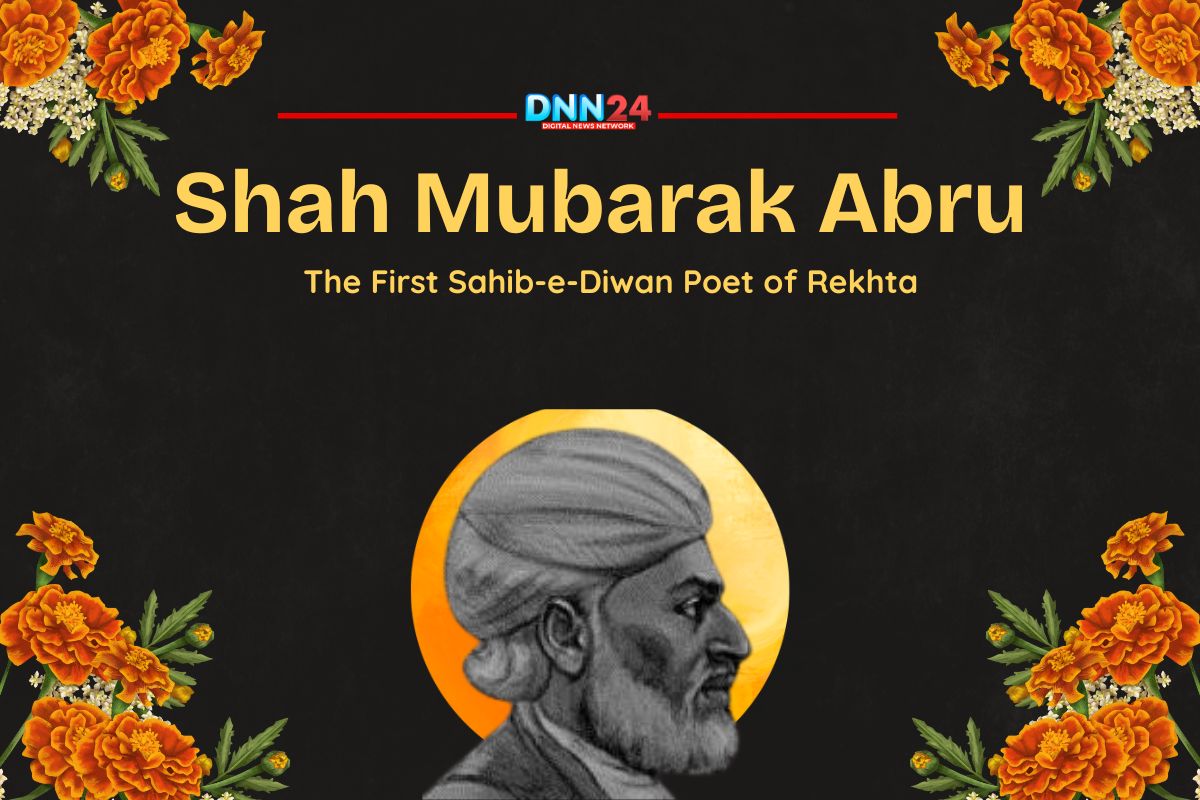Shah Mubarak Abru belonged to the earliest generation of Urdu poets who gave the language its distinct identity in northern India. At a time when Persian dominated the literary circles of Delhi, Abru helped transform Urdu into a language that ordinary people could embrace and enjoy. His work was not simply about composing verses.
aaj yaaron ko mubarak ho ki subah-e-eid hai
Shah Mubarak Abru
raag hai, mai hai, chaman hai, dilruba hai, deed hai
He captured the spirit of his times and brought it alive through words that resonated with ordinary folk. While the elite preferred Persian, Abru and his fellow poets chose to work in Urdu, giving it a character and dignity it had never possessed before. Born as Najamuddin Shah Mubarak Abru in Gwalior in 1683, he descended from the celebrated Sufi saint Muhammad Ghaus Gwaliyari.
duur khamosh baitha rahta hoon
Shah Mubarak Abru
is tarah haal dil ka kehta hoon
This family connection also linked him to Khan Arzu, a renowned scholar of Urdu and Persian, under whom he studied. Abru moved to Delhi as a young man and entered royal service, which brought him both wealth and respect. He became known as a prosperous man who lived comfortably during his years in the capital.
tumhare log kahte hain kamar hai
Shah Mubarak Abru
kahan hai, kis tarah ki hai, kidhar hai
From Persian Dominance to Rekhta Revolution
The arrival of Wali Deccani’s diwan in Delhi around 1720 marked a turning point for Urdu poetry. Before this moment, people viewed Urdu verse as something frivolous, a mere diversion from serious literary work. Wali demonstrated to Delhi that Urdu could convey depth and beauty equal to Persian. Inspired by this revelation, poets like Abru, Faiz, Sharafuddin Mazmun, and Muhammad Shakir Nazi embraced Rekhta wholeheartedly.
qaul ‘Abru’ ka tha ki na jaoonga us gali
Shah Mubarak Abru
ho kar ke be-qarar dekho aaj phir gaya
Scholars have long debated who deserves recognition as the first sahib-e-diwan poet of northern India. This title refers to someone whose complete collection of poetry has survived. Dr Muhammad Husain and other researchers point out that no solid evidence exists of Faiz’s diwan, and Hatim’s complete collection has also not survived.
bosan laban sin dene kaha kah ke phir gaya
Shah Mubarak Abru
pyala bhara sharab ka afsos gir gaya
This leaves Abru’s diwan as the first authenticated collection of Urdu poetry from the north. The distinction gives him a special place in literary history. His work represents a bridge between the old Persian tradition and the emerging Urdu voice that would later flower into one of the richest poetic traditions in the world.
afsos hai ki bakht hamara ulat gaya
Shah Mubarak Abru
aata to tha pe dekh ke hum kyun palat gaya
A Colourful Personality Reflecting Muhammad Shahi’s Glory
Abru’s poetry mirrors the Muhammad Shahi period in which he lived, a time marked by celebration, prosperity, and uninhibited enjoyment of life. His verses display the same frankness, the same vibrant spirit, and the same playfulness that characterised his era. He became one of the most important poets to popularise iham (double meaning) in Urdu poetry.
jalta hai ab talak teri zulfon ke rashk se
Shah Mubarak Abru
harchand ho gaya hai chaman ka charaagh gul
Many critics have faulted him for this, but the technique served both practical and artistic purposes. Abru and his contemporaries sought to have their poetry reflect Hindustani culture rather than Iranian influences. By using slesha (the Hindi equivalent of iham), they made their work accessible to ordinary listeners. Lucknow poets later adopted this same approach. His work offers a clear window into the social and cultural life of his time.
khudavanda karam kar fazl kar ahwal par mere
Shah Mubarak Abru
nazar kar aap par, mat kar nazar afaal par mere
Love in that period was not confined to heartbreak and suffering. Courtesans and handsome young men held a position of great esteem in society. Abru mentioned famous courtesans like Panna Mamola and Jamal in his verses, women who enjoyed celebrity status in their day. He praised not only their beauty but also their artistic accomplishments and talents as performers.
gham sin ahl-e-bait ke ji to tera kudhta nahin
Shah Mubarak Abru
yun abas padhta phira jo marsiya to kya hua
Life Beyond Conventions: Devotion and Mischief Combined
Very little information about Abru’s personal life has survived, but the available details paint an intriguing picture. He had lost the use of one eye, wore a long beard, and walked with a stick in his hand. In his later years, he adopted the life of a dervish and qalandar, following a path of spiritual wandering. His relationships with contemporary poets were marked by playful rivalry.
kya sabab tere badan ke garm hone ka sajan
Shah Mubarak Abru
aashiqon mein kaun jalta tha gale kis ke laga
Poets like Mazhar Jan-e-Janan and Benwa often mocked his physical disability rather than engaging with his poetry. Despite this, Abru maintained his distinctive personality. He enjoyed fine clothes and expensive garments. He played ganjifa (a card game) and kept pigeons as hobbies. His love for music and dance was well known.
muflisi sin ab zamane ka raha kuch haal nahin
Shah Mubarak Abru
aasman charkhi ke joon phirta hai lekin maal nahin
He maintained a close friendship with Sadarang, the famous court musician. Moved to Agra for some time, Abru composed verses expressing his longing for his friend. His character remained as bold and colourful as his poetry throughout his life. He refused to conform to expected behaviour, choosing instead to live according to his own principles and pleasures.
yun ‘Abru’ banave dil mein hazaar baatein
Shah Mubarak Abru
jab ru-ba-ru ho tere guftaar bhool jaave
A Legacy That Shaped Urdu’s Future
According to Mushafi, Abru lived only fifty years and died in 1733 after being kicked by a horse. His grave lies in Delhi near Syed Hasan Rasul Numa. Abru worked during a difficult transitional period and showed Urdu poetry a new direction. Through his verses, he broke free from Persian constraints and gave Urdu a distinctly Hindustani flavour. He did not restrict poetry to royal courts but carried it to ordinary people.
namkeen goya kabab hain pheeke sharab ke
Shah Mubarak Abru
bosa hai tujh laban ka mazedar chatpata
His work serves as a mirror to the society of his time, reflecting every shade of life in that period. His contribution extended far beyond writing one diwan. He strengthened the foundation of Urdu poetry at a critical moment in its development. He was the first poet to freely incorporate words and styles from Hindi and Braj Bhasha into Urdu, enriching the language and making it more expressive. This openness to multiple linguistic influences became one of Urdu’s greatest strengths in later centuries.
Also Read: Tahzeeb Hafi: Simple Words, Deep Emotions, and the Modern Urdu Poetry Revolution
You can connect with DNN24 on Facebook, Twitter, and Instagram and subscribe to our YouTube channel.

